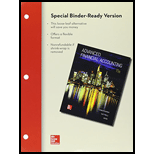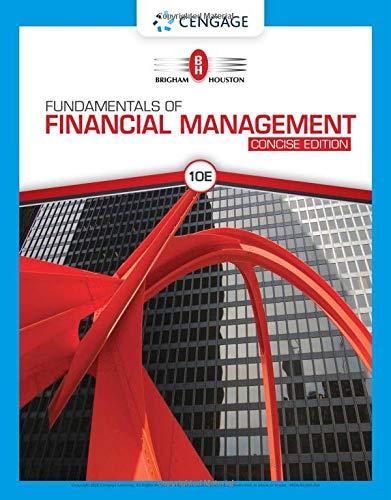
a
Introduction: Translation adjustment is the method used to convert the local currency into the parents’ functional currency when the local currency is the foreign entity’s functional currency. The current rate is used to translate the financial statements that are the exchange rate on the
The strengthening or weakening of currency in 20X6 and 20X7 by presenting both direct and indirect exchange rate for the rupees for the given dates.
a
Answer to Problem 12.13E
The dollar strengthened both during 20X6 and 20X7
Explanation of Solution
| Direct $/R 1 | Indirect R/$1 | |
| January 1, 20X6 | $.03333 = R 1 | R 30 = $1 |
| December 31, 20X6 | $.02857 = R 1 | R 35 = $1 |
| December 31, 20X7 | $.025 = R 1 | R40 = $1 |
The dollar appreciated against rupees during 20X6 because the amount of rupees required to buy one U.S dollar at the end of the year is R35 which is greater than the amount of rupees required to buy one dollar at the beginning of the year that is R 30. The dollar value continued its upward trend during the year 20X7 to R40.
b
Introduction: Translation adjustment is the method used to convert the local currency into the parents' functional currency when the local currency is the foreign entity’s functional currency. The current rate is used to translate the financial statements that are the exchange rate on the balance sheet date. The average rate is used to translate revenue and expenses as it is assumed that occurs uniformly over the period. Any gain or loss on account of translation adjustment is recognized in the comprehensive income statement.
The subsidiary’s translated balance sheet of December 31, 20X6 assuming rupee is the subsidiary’s functional currency.
b
Answer to Problem 12.13E
The dollar strengthened both during 20X6 and 20X7
Explanation of Solution
Translated balance sheet for December 31, 20X6
| Details | Subsidiary balancesIn Rupees | Direct exchange rate | Translated balances$ |
| Cash | 100,000 | $.02857 | $2,857 |
| Receivables | 450,000 | $.02857 | 12,857 |
| Inventory | 680,000 | $.02857 | 19,428 |
| Fixed assets | 1,000,000 | $.02857 | 28,570 |
| Total assets | 2,230,000 | 63,712 | |
| Accumulated other comprehensive income: | |||
| Translation adjustment debit | 2,903 | ||
| Total Assets | 66,615 | ||
| Current payables | 260,000 | $.02857 | 7,428 |
| Long term debts | 1,250,000 | $.02857 | 35,713 |
| Common stock | 500,000 | $.03333 | 16,665 |
| 220,000 | $03095 | 6,809 | |
| Total Liabilities and Equity | 2,230,000 | 66,615 |
Exchange rate for retained earnings will be average of beginning and ending exchange rate
Working note: Proof of translation adjustment
| Details | In Rupees | translation rate | $ |
| Net assets 1/1/X6 | 500,000 | $.03333 | 16,665 |
| Adjustment for changes in net assets during year | |||
| Net income | 220,000 | $.03095 | 6,809 |
| Net assets translated at: | |||
| Rates during the year | 23,474 | ||
| Rates at end of the year | 720,000 | $.02857 | (20,570) |
| Change in translation adjustment during year | 2,904 |
c
Introduction: Translation adjustment is the method used to convert the local currency into the parents' functional currency when the local currency is the foreign entity’s functional currency. The current rate is used to translate the financial statements that are the exchange rate on the balance sheet date. The average rate is used to translate revenue and expenses as it is assumed that occurs uniformly over the period. Any gain or loss on account of translation adjustment is recognized in the comprehensive income statement.
The subsidiary translated balance sheet as of December 31, 20X7 assuming the rupee is the subsidiary functional currency
c
Answer to Problem 12.13E
Balance sheet total after translation adjustment $61,885
Explanation of Solution
| Details | Subsidiary balancesIn Rupees | Direct exchange rate | Translated balances$ |
| Cash | 80,000 | $.025 | $2,000 |
| Receivables | 550,000 | $.025 | 13,750 |
| Inventory | 720,000 | $.025 | 18,000 |
| Fixed assets | 900,000 | $.025 | 22,500 |
| Total assets | 2,250,000 | 56,250 | |
| Accumulated other comprehensive income: | |||
| Translation adjustment debit | 5,635 | ||
| Total Assets | 61,885 | ||
| Current payables | 340,000 | $.025 | 8,500 |
| Long term debts | 1,100,000 | $.025 | 27,500 |
| Common stock | 500,000 | $.03333 | 16,665 |
| Retained earnings | 310,000 | A | 6,809 |
| Total Liabilities and Equity | 2,250,000 | 61,885 |
Determination of retained earnings
| Retained earnings December 31, 20X6 | $6,809 |
| 2,411 | |
| $9,220 |
Working note: Proof of translation adjustment
| Details | In Rupees | translation rate | $ |
| Net assets 1/1/X6 | 720,000 | $.02857 | 20,570 |
| Adjustment for changes in net assets during year | |||
| Net income | 90,000 | $.02679 | 2,411 |
| Net assets translated at: | |||
| Rates during the year | 22,981 | ||
| Rates at end of the year | 810,000 | $.025 | (20,250) |
| Income translation | 2,731 | ||
| Translation adjustment 1/1/X7 | 2,904 | ||
| Accumulated other comprehensive | |||
| Translation adjustment 12.31.X7 | 5,635 |
d
Introduction: Translation adjustment is the method used to convert the local currency into the parents' functional currency when the local currency is the foreign entity’s functional currency. The current rate is used to translate the financial statements that are the exchange rate on the balance sheet date. The average rate is used to translate revenue and expenses as it is assumed that occurs uniformly over the period. Any gain or loss on account of translation adjustment is recognized in the comprehensive income statement.
The comprehensive income for 20X7 would include as a result of the translation
d
Answer to Problem 12.13E
The comprehensive income for 20X7 would include as a result of the translation $2,731
Explanation of Solution
Income to be reported in 20X7
| Details | In Rupees | translation rate | $ |
| Net assets 1/1/X6 | 720,000 | $.02857 | 20,570 |
| Adjustment for changes in net assets during year | |||
| Net income | 90,000 | $.02679 | 2,411 |
| Net assets translated at: | |||
| Rates during the year | 22,981 | ||
| Rates at end of the year | 810,000 | $.025 | (20,250) |
| Income translation | 2,731 |
Want to see more full solutions like this?
Chapter 12 Solutions
LOOSE-LEAF Advanced Financial Accounting with Connect
- Space Exploration Technology Corporation (Space X), is an aerospace manufacturer that sells stock engine components and tests equipment for commercial space transportation. A new customer has placed an order for eight high-bypass turbine engines, which increase fuel economy. The variable cost is $1.6 million per unit, and the credit price is $1.725 million each. Credit is extended for one period, and based on historical experience, payment for about one out of every 200 such orders is never collected. The required return is 1.8% per period. Required Assuming that this is a one-time order, should it be filled? The customer will not buy if credit is not extended. What is the break-even probability of default in part 1? Suppose that customers who don’t default become repeat customers and place the same order every period forever. Further assume that repeat customers never default. Should the order be filled? What is the break-even probability of default?arrow_forwardCan you explain the correct methodology to solve this general accounting problem?arrow_forwardPlease help me solve this general accounting question using the right accounting principles.arrow_forward
- Suppose during 2025 that Federal Express reported the following information (in millions): net sales of $82,500 and net income of $185. Its balance sheet also showed total assets at the beginning of the year of $27,000 and total assets at the end of the year of $23,000. Calculate the asset turnover and return on assets. (Round answers to 2 decimal places, e.g. 6.25 or 6.25%.) Asset turnover Return on assets times %arrow_forwardThe shareholders of Barley Corporation have voted in favor of a buyout offer from Wheat Corporation. Information about each firm is given here: Barley Wheat Price/earnings ratio 13.5 21 Shares outstanding 90,000 210,000 Earnings $180,000 $810,000 Barley shareholders will receive one share of Wheat stock for every three shares they hold of Barley. Required What will the EPS of Wheat be after the merger? What will be the P/E ratio if the NPV of the acquisition is 0? What must Wheat feel is the value of the synergy between these two firms? Explain how your answer can be reconciled with the decision to go ahead with the takeover?arrow_forwardI am trying to find the accurate solution to this general accounting problem with the correct explanation.arrow_forward
- Please provide the answer to this general accounting question with proper steps.arrow_forwardRespond to jane Plant assets of DTPW are essential to the County’s transportation services and infrastructure. These assets consist of physical, long-term resources including our vast Metrorail and Metromover systems, maintenance facilities, administrative buildings, bus depots, and train stations. DTPW depends greatly on machinery such as fare collection machines, elevators, escalators, signaling devices, and track systems which are necessary to ensure that our daily operations go off without a hitch. For example, our buses and service trucks are regarded as plant assets since they help the department fulfill its goal of providing dependable and effective transportation across the County. These assets are valuable in addition to being physically noteworthy because they reflect large investments made to preserve accessibility, safety, and public transportation. For long-term planning and financial reporting, these assets have to be properly managed and their depreciation tracked.…arrow_forwardCan you solve this general accounting question with accurate accounting calculations?arrow_forward
 Financial Reporting, Financial Statement Analysis...FinanceISBN:9781285190907Author:James M. Wahlen, Stephen P. Baginski, Mark BradshawPublisher:Cengage Learning
Financial Reporting, Financial Statement Analysis...FinanceISBN:9781285190907Author:James M. Wahlen, Stephen P. Baginski, Mark BradshawPublisher:Cengage Learning Fundamentals Of Financial Management, Concise Edi...FinanceISBN:9781337902571Author:Eugene F. Brigham, Joel F. HoustonPublisher:Cengage Learning
Fundamentals Of Financial Management, Concise Edi...FinanceISBN:9781337902571Author:Eugene F. Brigham, Joel F. HoustonPublisher:Cengage Learning




